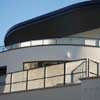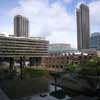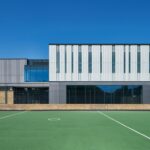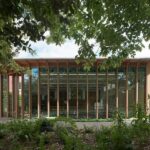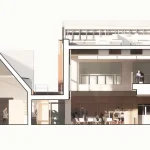Golden Lane Campus Building, Brutalist Architecture London, Photo, Design, Architect
Golden Lane Campus, London
Brutalist Architecture: Islington School Buildings, UK – design by Nicholas Hare Architects
6 Mar 2008
Golden Lane Campus London
Nicholas Hare Architects are celebrating thirty years in practice with the completion of their latest education project in London.
Golden Lane Campus, is adjacent to the Grade II listed Barbican Centre and involves the relocation and integration of three successful schools onto a single, complex site in Islington.
Golden Lane Campus brings together the primary department of Richard Cloudesley School, for children with physical disabilities, Prior Weston Primary School, Fortune Park Nursery, and Surestart Early Years Centre.
Nicholas Hare Architects (NHA) were appointed following a design competition in March 2005 and set out to design an innovative and inclusive education campus on a site that has a strong architectural and planning legacy. The vision behind the amalgamation of the three institutions on one site is based on a commitment to inclusive education for all and removing barriers to achievement.
Founding partner, Nicholas Hare says, “The firm’s continuing success is the result of a commitment to imaginative but practical design solutions and the unique collaboration between the architects, their clients, consultants and contractors.”
Hare has maintained a fruitful relationship with the education sector throughout his career. After studying Natural Sciences and English at Corpus Christi College, Cambridge, he studied architecture at Liverpool University and University College, London. Since then he has acted as a Visiting Lecturer, external examiner and consultant architect to various universities. Although their practice includes a wide range of typologies, the practice’s educational projects are a significant highlight in their catalogue.
Golden Lane Campus in particular, is one of the many Nicholas Hare Architect’s schemes that fully reflects the principles which guide their approach to an expanding range of design challenges: the importance of context; sustainability; natural light; delight in construction and orientation.
The importance of context
This applies both to the physical context of a project – its ‘sense of place’ – and to the context established by the client’s own aspirations. Nicholas Hare Architects believe that a design should be responsive to both of these, rather than arising from overwhelming design prejudice. This is the reason why their projects may appear quite different from each other, although guided by consistent principles.
The Education Centre for the Royal College of Obstetricians and Gynaecologists is an excellent example of where their design solution has successfully melded the existing space (a garden) with a new space (the Education Centre) to create a unique place. The project was awarded the Civic Trust Award in 2002 as well as Concrete Society’s overall award for outstanding structure.
Sustainability
Concern for the environment is central to their work, ranging from the siting of buildings to the selection of materials and from energy efficiency to controlling waste. For example, at the Learning resources Centre for Wye College (awarded a 1997 RIBA Award) the building is sited to allow existing rows of pleached trees to provide shading from sunshine in summer but admit it to warm the building in winter.
At the headquarters building for the Royal Veterinary College, Nicholas Hare Architects pioneered the use of ground coupling for heating and cooling in conjunction with displacement ventilation, while the Student Services Centre at Southampton university (2007 RIBA Award) uses photovoltaic cells to filter light into the atrium as well as generate electricity.
Natural light
The imaginative use of natural light is fundamental to the expression and enjoyment of interior space. It is a vital part of reducing energy use, since in most modern buildings artificial lighting represents a high proportion of energy cost. NHA try to make this a general rule that we should not need to switch lights on during normal daylight. This can have profound implications for building form, as well as contributing to both economy and delight.
Their Collège Doctoral Européen for the University of Strasbourg, completed in 2007, is a recent achievement of this design principal. The curved atrium adheres to both the site’s building restrictions and provides ample natural light to both the public and private spaces.
Delight in construction
One aspect of the language of architecture which NHA enjoys is the direct expression of the means of construction of buildings. This implies expressing the essential nature of the various materials, such as massive masonry walls, slender steel ties, taut panels of glass, as well as carefully articulating the joints between them.
For example, the Research and Development HQ for Nokia (UK) Ltd. in Farnborough boasts a wide range of materials in a variety of juxtapositions. Completed in 1999, their scheme realized a number of complex, high-tech solutions that involved a large amount of specialist equipment to facilitate the building’s programme.
Orientation
Most of us need help in finding our way around places and buildings. In design terms this means imagining what it will be like to inhabit the spaces we are designing and specifically relating circulation routes to spaces so that our sense of orientation is reinforced. It also suggests a comprehensible relationship between primary and secondary spaces and routes. All this implies a measure of spatial clarity which has nothing to do with symmetry or repetition; it is strengthened by variation and a sense of discovery or even surprise – and it is enhanced by the treatment of light, sound and materials.
These principles are set out in a new practice brochure designed by Studio fernando gutiérrez being published to coincide with their thirty years celebration. These will be made available at their celebration on Thursday 6 March at Golden Lane Campus.
Golden Lane Campus context : The Barbican Centre
In 2004, Nicholas Hare Architects became a limited liability partnership: three longstanding colleagues, Paul Baxter, Carol Lelliott and Jayne Bird joined Nicholas and Sophie Hare as partners. The practice is organized in open studios. Teams are formed for each project and each team has a designated project leader. Today, the practice numbers about 50 people and continues to grow organically.
Golden Lane Campus London image / information received 060308
Location: Barbican Centre, London, England, UK
London Buildings
Contemporary London Architecture
London Architecture Links – chronological list
London Architecture Tours by e-architect
Golden Lane Estate Leisure Centre
redevelopment – Cartwright Pickard
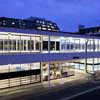
photograph : Hundven Clements Photography
Golden Lane Estate Leisure Centre
Golden Lane Estate + Barbican Centre architects : Chamberlin, Powell and Bon
Barbican Centre context
Museum of London, southwest corner of Barbican Centre complex
Contemporary London Architecture
Comments / photos for Golden Lane Campus Architecture page welcome

